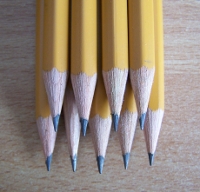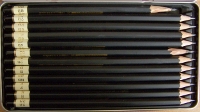‘ Instrument serving to write, to draw, generally formed by a graphite mine or by a colouring enclosed in a soft wooden armature. ‘
Larousse Encyclopédia (personal traduction)
The pencil is one of the mediums the most used in drawing. It is moreover with the pencil graphite which the beginner begins generally to draw.
A little of history
For a long time, the man drew (on the walls of caves for example) by using pigments or calcined wood. But when he wanted to write (in the antiquity), he used calames in reed cut to use it with some ink. And yes, the ink is discovered before the pencil! There was however a problem: the ink had to hold in a bowl which was not always practical for the scribes of time.
The Roman discovered the usage of the lead cut in the shape of style ( plumbum ). They also used the pure graphite because it left a trace more black. But this pure graphite was rare and thus expensively. In the Middle Ages, scribes used the nib but to XI e century, we discovered the lead pencil. The graphite was, constituted by 1/3 of tin and by 2/3 of lead. This mine will be abandoned in the middle of XIX e century. As you can see, various forms of mediums were used at the same time.
By 1564-1565, English discovered a field of very pure graphite to Borrowdale. We were thus able to begin to exploit it in a wider way. The graphite was called “Plombagine” because we considered it stemming from some lead. (It is probably the origin of the name of “graphite”). As this stick of graphite was very dirty, one had the idea to surround it with wood, but not only: there are also pencils surrounded with paper (in my course of drawing, we call it the pencil which speaks, because of the text written on this paper.) or surrounded with a plastic film nowadays.
As I said it, the pure graphite is very expensive and thus, we looked for a long time for substitutes. By 1760, Kaspar Faber created a factory of pencil but he used a binding agent such as gums, resins, glue and other materials. Therefore, the quality is not really the strong point of these pencils.
By 1779, the Swedish chemist Carl Scheele discovered that the graphite arose from some carbon and not from some lead. We thus owe him his definitive name of ‘graphite’ (Greek grafein, which means ‘writing’).
By 1795, the chemist Nicolas Conté mixed this graphite in some clay and some water, what allowed to make it lower the cost and to use some less pure graphite. This paste made by graphite and by clay is cooked in more than 1000 °C to give the mine of the pencil (the clay serves of linking). This pencil being of much better quality, he can so become widespread. The wood could be various essences of trees according to the quality of the pencil:
* Linden and spruce for the common pencils;
* Cedar for the beautiful pencils.
If you wish to express your opinion, you can make it in this article. If you wish to inform me about an error or about a modification, contact me!


Pingback: Graphite pencil | Drawing and Painting